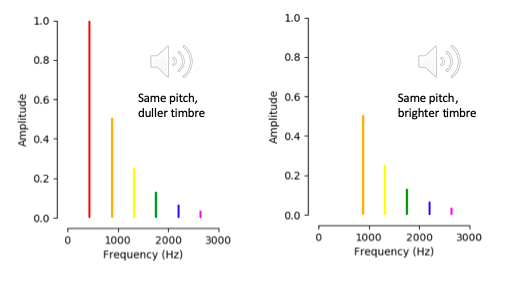Hearing Loss and Central Auditory Processing
59
Learning Objectives
Understand why pitch perception is different than only tone presentation.
Be able to describe what brain regions play a role in pitch perception.
Pitch plays a crucial role in acoustic communication. Pitch variations over time provide the basis of melody for most types of music; pitch contours in speech provide us with important prosodic information in non-tone languages, such as English, and help define the meaning of words in tone languages, such as Mandarin Chinese. Pitch is essentially the perceptual correlate of waveform periodicity, or repetition rate: The faster a waveform repeats over time, the higher its perceived pitch is. The most common pitch-evoking sounds are known as harmonic complex tones. They are complex because they consist of more than one frequency, and they are harmonic because the frequencies are all integer multiples of a common fundamental frequency (F0). For instance, a harmonic complex tone with a F0 of 100 Hz would also contain energy at frequencies of 200, 300, 400 Hz, and so on. These higher frequencies are known as harmonics or overtones, and they also play an important role in determining the pitch of a sound. In fact, even if the energy at the F0 is absent or masked, we generally still perceive the remaining sound to have a pitch corresponding to the F0. This phenomenon is known as the “pitch of the missing fundamental,” and it has played an important role in the formation of theories and models about pitch (de Cheveigné, 2005). We hear pitch with sufficient accuracy to perceive melodies over a range of F0s from about 30 Hz (Pressnitzer, Patterson, & Krumbholz, 2001) up to about 4–5 kHz (Attneave & Olson, 1971; Oxenham, Micheyl, Keebler, Loper, & Santurette, 2011). This range also corresponds quite well to the range covered by musical instruments; for instance, the modern grand piano has notes that extend from 27.5 Hz to 4,186 Hz. We are able to discriminate changes in frequency above 5,000 Hz, but we are no longer very accurate in recognizing melodies or judging musical intervals.

It turns out that the primary auditory cortex (A1) is necessary but not sufficient for pitch perception. If you have damage to A1, you lose the ability to identify pitches. But the neural responses in A1 are not enough to predict what pitch someone will perceive—if you experience brain damage to the inferior temporal cortex, you lose the ability to recognize tones.
For more information about pitch perception, here is a video about psychoacoustics.
Oxenham, A. J. (2020). Hearing. In R. Biswas-Diener & E. Diener (Eds), Noba textbook series: Psychology. Champaign, IL: DEF publishers. Retrieved from http://noba.to/jry3cu78
Oxenham, A. J., Micheyl, C., Keebler, M. V., Loper, A., & Santurette, S. (2011). Pitch perception beyond the traditional existence region of pitch. Proceedings of the National Academy of Sciences USA, 108, 7629–7634.
Pressnitzer, D., Patterson, R. D., & Krumbholz, K. (2001). The lower limit of melodic pitch. Journal of the Acoustical Society of America, 109, 2074–2084.
de Cheveigné, A. (2005). Pitch perception models. In C. J. Plack, A. J. Oxenham, A. N. Popper, & R. Fay (Eds.), Pitch: Neural coding and perception (pp. 169–233). New York, NY: Springer Verlag.

